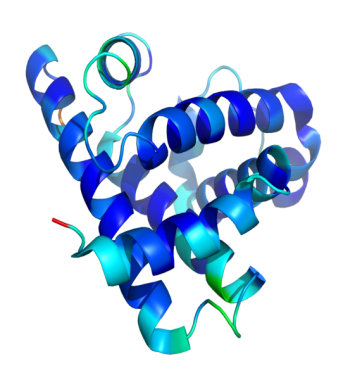Practice Essentials
Myoglobinuria is usually the result of rhabdomyolysis or muscle destruction. [1] Any process that interferes with the storage or use of energy by muscle cells can lead to myoglobinuria. The release of myoglobin from muscle cells is often associated with an increase in levels of creatine kinase (CK), aldolase, lactate dehydrogenase (LDH), serum glutamic-pyruvic transaminase (SGPT), and other enzymes. When excreted into the urine, myoglobin, a monomer containing a heme molecule similar to hemoglobin, can precipitate, causing tubular obstruction and acute kidney injury.
A clinician caring for a patient with crush injuries or other causes of muscle destruction must recognize the presence and severity of myoglobinuria and initiate aggressive hydration to prevent acute kidney injury.
The most common causes of myoglobinuria in adults are trauma, alcohol and drug abuse, usually in relation to muscle necrosis from prolonged immobilization and pressure by the body weight. Prolonged ethanol consumption and seizure activity, similar to excessive physical activity, can produce an imbalance between muscle energy consumption and production, resulting in muscle destruction. In children and adolescents, the most common causes of rhabdomyolysis and myoglobinuria are viral myositis, trauma, exertion, drug overdose, [2] seizures, metabolic disorders, and connective tissue disease.
Pathophysiology
Myoglobin is released from muscle tissue by cell destruction and alterations in the permeability of the skeletal muscle cell membrane. [3, 4, 5] Under normal conditions, the sodium potassium ATPase pump maintains a very low intracellular sodium content. A separate sodium-calcium channel then serves to pump additional sodium into the cell in exchange for calcium extrusion from the cell. In addition, most intracellular calcium is normally sequestered within organelles. Damage to muscle cells interferes with both mechanisms, leading to an increase in free ionized calcium in the cytoplasm. The high intracellular calcium activates numerous calcium-dependent enzymes that further break down the cell membrane, leading to the release of intracellular contents such as myoglobin and creatine kinase into the circulation. A model of the helical domains of myoglobin is shown in the image below.
Myoglobin is a dark-red, 17,8-kDa, monomeric heme protein that contains iron in its ferrous (Fe+2) form. [4] It is easily filtered by the glomerulus and is rapidly excreted into the urine. Plasma levels of myoglobin rapidly fall after its release. When large amounts of myoglobin enter the renal tubule lumen, it interacts with the Tamm-Horsfall protein and precipitates; this is a process favored by acidic urine. Tubule obstruction principally occurs at the level of the distal tubule. In addition, reactive oxygen species generated by damage to both muscle and kidney epithelial cells promote the oxidation of ferrous oxide to ferric oxide (Fe+3), thus generating a hydroxyl radical. Both the heme moieties and the free iron-driven hydroxyl radicals may be critical mediators of the direct tubule toxicity, which mainly occurs in the proximal tubule.
Thus, the precipitation of myoglobin in the renal tubules with secondary obstruction, tubular toxicity, or both constitutes the primary causes for acute kidney injury during myoglobinuria. A higher volume of urine flow and a higher urine alkalinity prevent myoglobin from precipitating as readily as it otherwise does.
Etiology
Trauma and compression
Trauma is one of the most common cause of myoglobinuria. Patients who experience crush injuries, such as those that occur when individuals are buried after earthquakes, have rhabdomyolysis and myoglobinuria. Volume depletion from fluid sequestration in damaged tissues and poor fluid intake accentuate the possibility of acute renal insufficiency. Electric shock can cause enough muscle damage to precipitate myoglobinuria.
Exertion
Exertional myoglobinuria occurs in most athletes but rarely becomes symptomatic unless combined with poor training, inadequate oral intake, dehydration, and heat exhaustion. Trauma from repeated blows to the muscle always releases myoglobin into the system. The treatment is prevention, which includes plentiful fluid, limited exercise during particularly hot periods, and avoiding muscle trauma. Athletes have more myoglobin in their muscles than other individuals and are prone to symptoms when small amounts of muscle tissue are damaged. [6, 7]
Viral myositis
Viral infections from a wide variety of organisms can cause myositis and myoglobinuria. Viral myositis is one of the most common causes of rhabdomyolysis in children. [8] Influenza is the predominant viral agent associated with rhabdomyolysis. The patient usually presents with generalized weakness and myalgias, particularly in the back and proximal extremities. Children with influenza A and influenza B viral infections can present with tenderness in calves and lower extremities. [9]
Cases of rhabdomyolysis related to coronavirus disease 2019 (COVID-19), with associated myoglobinuria, have been reported in the United States, as well as in other countries. [10, 11, 12, 13]
Electrolyte disorders
Metabolic diseases, particularly those involving muscle metabolism, may be associated with myoglobinuria. Males are affected more often, and symptomatology is exacerbated by exercise and heat injuries. Potassium depletion has been particularly associated with myoglobinuria.
Toxins, drugs, and diet
Snakebites and other venoms can cause muscle necrosis and myoglobinuria. [14]
Some drugs predispose individuals to rhabdomyolysis, including AZT (used to treat acquired immunodeficiency syndrome [AIDS]) and lovastatin (used to treat hypercholesterolemia). However, statin-induced rhabdomyolysis is rare and occurs in less than 0.1% of all users.
Alcohol, cocaine, amphetamines, phencyclidine, ecstasy, and some dietary supplements can lead to myoglobinuria. [15]
Ingestion of ethylene glycol, isopropyl alcohol, and phencyclidine has been associated with myoglobinuria.
Overindulgence in quail can also cause myoglobinuria in some patients.
Infection or sepsis syndromes
Syndromes involving muscle destruction include gas gangrene, tetanus, Legionnaire disease, or shigellosis. Coxsackie viral infections with myositis may be the most common cause of mild myoglobinuria.
Endocrine disorders
Diabetic ketoacidosis, myxedema, and nonketotic hyperosmolar comas can disrupt muscle energy.
Malignant hyperthermia and high fevers
These may be contributors.
Hereditary myopathies
Hereditary myopathies, such as McArdle syndrome and muscular dystrophy, can precipitate myoglobinuria.
The differential diagnosis for myoglobinuria must include metabolic myopathies. This diverse and complex list of disorders is long, with new additions each year.
In general, patients with myopathies report exercise intolerance, muscle pain, and cramps rather than weakness. Patients with some types of muscular dystrophy or inflammatory myositis (eg, dermatomyositis, polymyositis) may present with progressive weakness.
Metabolic disorders
Patients with defects of carbohydrate metabolism (eg, myophosphorylase, phosphofructokinase, phosphohexoisomerase deficiency) have symptoms of easy fatigability or cramping induced by dynamic isometric exercise, such as heavy lifting, or prolonged exercise, such as swimming or running. Acute muscle breakdown can lead to myoglobinuria. These patients typically present after participating in high-intensity exercise, such as weight lifting.
Defects in lipid metabolism include carnitine deficiency, beta-oxidation enzyme deficiency, or disorders of fatty acid transport. Prolonged fasting or prolonged activity induces muscle pain and myoglobinuria. Fever, sepsis, and exposure to cold can also induce muscle fatigue in this set of disorders. These patients typically develop symptoms after prolonged low-intensity exercise, such as walking.
Patients with mitochondrial disorders (beta-oxidation disorders) usually present with static and progressive muscular weakness. Failure to thrive, floppy-baby syndrome, and generalized muscle weakness are present in most of these children. Patients usually present with chronic muscle cramping and weakness rather than episodic muscle cramping and weakness. Patients with some types of muscular dystrophy or inflammatory myositis may present with progressive weakness.
A case study reinforced the idea that myoglobinuria should be considered a manifestation of a primary sarcoglycanopathy, even as the only recognizable sign at the debut of the disease. [16]
Heat exhaustion and cold exposure
These conditions induce abnormal muscle metabolism by means of various mechanisms, including poor perfusion and decreased oxygenation, acidosis, rhabdomyolysis, or glucose and/or glycogen depletion. [17] Reye syndrome may also be included in this group. Patients with recurrent exercise-induced myoglobinuria may have defective carnitine palmitoyltransferase activity. [18]
Epidemiology
United States statistics
The frequency of myoglobinuria varies with the incidence of natural disasters and environmental trauma. Epidemics of viral myositis may temporarily increase the incidence in local areas. In urban areas with a high incidence of drug and alcohol abuse, many patients with myoglobinuria may present to emergency departments. Hot weather increases the incidence of stress induced rhabdomyolysis, especially in young athletes.
International statistics
Acute kidney injury due to rhabdomyolysis was first described by Bywaters and Beall during World War II; they noted the hypovolemic shock, dark urine, and kidney failure that developed in survivors from the rubbles of the London bombings. Crush injuries related to earthquakes and other natural disasters are the major cause of cases reported internationally. Any person dug from the rubble of such disasters should be considered to have rhabdomyolysis, myoglobinuria, and potential acute renal failure and, therefore, should be given rapid fluid resuscitation.
Race-, sex-, and age-related demographics
Race
Race is a factor only when natural disasters and economic shortfalls increase the rates of drug and alcohol abuse and the mortality rate among certain racial groups.
Sex
Myoglobinuria tends to affect males more than females because of the former group's predisposition to trauma and participation in strenuous physical exercise. Persons who exercise and have increased muscle mass have an increased intracellular myoglobin content.
Age
In a large retrospective review, the median age was 11 years. [19] The leading cause of rhabdomyolysis in the 0-9 year age range was viral myositis, whereas the leading diagnosis in the 9-18 year age range was trauma.
Prognosis
Patients with uncomplicated cases of myoglobinuria recover without sequelae.
Myoglobinuria causes little or no morbidity or mortality unless it is associated with the secondary complications of rhabdomyolysis, including hyperkalemia, hypocalcemia, and acute kidney injury. [3] However, when it is associated with severe rhabdomyolysis, myoglobinuria-induced acute renal failure is a potentially lethal complication.
In adults, rhabdomyolysis can be complicated by acute kidney injury in approximately 30% of patients, [20] with about 5% of those requiring hemodialytic support. In the pediatric age group, although previous small case series reported acute renal failure rates of 40-50%, a large retrospective review indicates that only about 5% of subjects with rhabdomyolysis develop acute kidney injury (defined as a serum creatinine level >97.5 percentile for age and gender). [19] Rhabdomyolysis accounts for or contributes to about 7% of all causes of acute kidney injury in the United States. [21] In both adults and children, the overall mortality rate of acute severe rhabdomyolysis is reported to be 7-8% and is primarily related to acute renal failure and multiorgan failure.
Complications
The most serious complication of myoglobinuria is acute renal failure.
Other complications can result from renal shutdown or from the intracellular products released into the system by rhabdomyolysis.
Patient Education
Patients who develop exercise-induced rhabdomyolysis need education in maintaining adequate fluid intake, in oral rehydration, and in pacing their exercise in hot weather or extreme conditions.
-
Model of helical domains in myoglobin.








